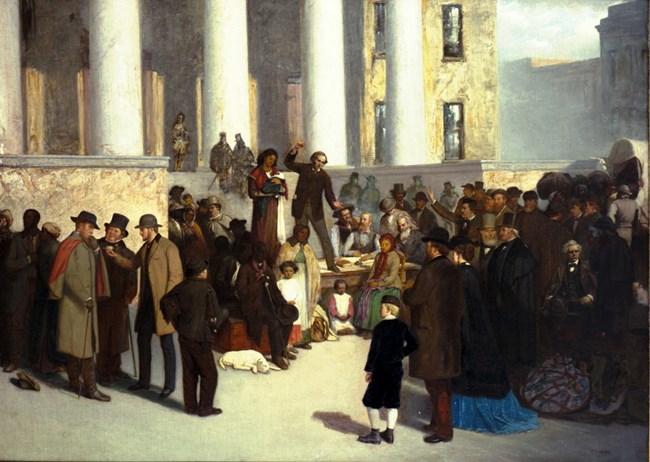Last updated: March 1, 2023
Article
Fighting Back Against the Shackles of Slavery in St. Louis

Missouri Historical Society
The laws passed when slavery existed in St. Louis were designed to keep enslaved people from advancing in society. Educational opportunities, social activities, religious functions and even their freedom of movement were monitored or outlawed by white authorities. The Code Noir which governed slavery in St. Louis during French and Spanish rule (1764-1803) forbid the separation of families, allowed enslaved people to be educated, work for extra money on Sundays and even own businesses and property. Despite these slight freedoms,there were extreme restrictions for enslaved people under the Code Noir system. They had to convert to Catholicism, which outlawed their traditional beliefs and culture, could not leave their enslaver’s land without permission, and could face severe punishments such as brandings, whippings, disfigurement and even executions for severe transgressions.
In 1803 St. Louis became part of the United States as part of the Louisiana Purchase. Despite ongoing Code Noir traditions regarding slavery in St. Louis, slavery restrictions changed under US control. Besides long hours laboring, enslaved people now faced the horrible prospect of family separation. The founder of the Missouri Botanical Gardens, Henry Saw, enslaved a woman named Esther. When Esther was captured while trying to escape slavery by way of the Mississippi River to Illinois, he separated her from her children by selling her down river. In a very restrictive law passed by the Missouri Legislature in 1847, it became illegal for both enslaved and free African Americans to be taught to read or write. The act also restricted African American assemblages and banned free black immigration to Missouri.
Despite this repressive system enslaved African Americans in the St. Louis area found ways to resist slavery and in so doing helped undermine the institution. Much of the resistance was nonviolent, however violence to resist slavery did occur with the most famous examples in other states like Nat Turner’s rebellion in Virginia 1831. Everyday resistance included: slowing down work, breaking tools, and feigning illness. Other non-violent forms or resistance included the occasional self-manumission, in the rare instance in which the enslaved was allowed to make money outside of their normal working schedule, also using the court system as in the famous Dred Scott case. Running away was also a big form of resistance, however this came with a risk of being recaptured or leaving friends and family behind with the possibility of never seeing loved ones again.
Acts of resistance can even be found in Julia Dent Grant’s memoirs regarding her own family’s enslaved laborers on White Haven. She often looked back on enslaved life at White Haven in a positive light, writing, “I think our people were very happy…although the young ones became somewhat demoralized about the beginning of the rebellion, when all the comforts of slavery passed away forever.” She also said that “my father was most kind and indulgent to his people.” Also, they had access to “everything that the farm produced such as all vegetables, bacon, beef and of course poultry.” Julia neglected to say that it was because of the labor of the enslaved that the farm produced these things. Yet actions speak louder than words. She writes that Bob, one of the older enslaved laborers at White Haven, was “frightened or had his dear old tender hear touched by some special kindness” and would “get religion…he would go away down in the meadow by the big walnut tree nearly a half mile off and pray and sing.” She also remembered “Old Bob” whose labor was to take care of the fires in the house would be “careless and let his fires go out…he would have to walk a mile to some neighbors and bring home a brand of fire from their backlog.” What Julia couldn’t comprehend was that Bob’s “carelessness” or gaining “religion” would allow him some degree of freedom away from the prying eyes of the Dent family. Finally, Julia talks about how her “menservants,” Charles, Bob, Willis, William, and Jim, would take advantage of her being spoiled by her father. They would go through her to get things they wanted from Dent such as, extra tobacco, provisions for the cold and even permission to visit or provide gifts for their families who were enslaved on nearby properties. All these cases were subtle forms of resistance surely not isolated to the property at White Haven.
